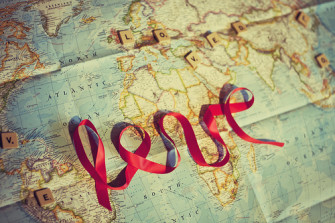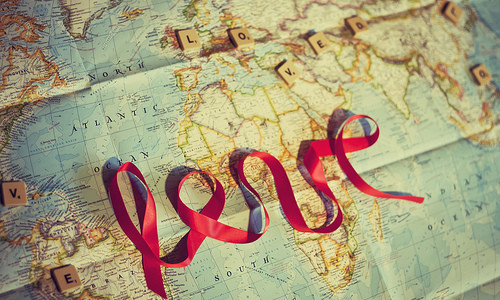Global Valentines Traditions
 Love it or hate it, Valentine’s Day has spread around the world, resulting in unique traditions from country to country. Sure, sometimes the U.S. can be a little superficial with red roses and sentimental cards, but its not all SweeTarts and teddy bears everywhere. From Beijing to Iraq, different cultures express their love distinctly. Some dangle from cliffs while others enter kissing competitions. See what else is happening around the world on this international day of romance.
Love it or hate it, Valentine’s Day has spread around the world, resulting in unique traditions from country to country. Sure, sometimes the U.S. can be a little superficial with red roses and sentimental cards, but its not all SweeTarts and teddy bears everywhere. From Beijing to Iraq, different cultures express their love distinctly. Some dangle from cliffs while others enter kissing competitions. See what else is happening around the world on this international day of romance.
Thailand
In Thailand, the holiday has literally taken flight. Hanging off the sides of cliffs, sky-diving and underwater wedding packages have become trending ways to tie the knot among adventure-loving Thai couples. Afraid of heights? Can’t swim? Don’t worry. Thailand has a number of other growing traditions. Thai women flock to the Trimurti shrine where they lay red roses, candles and incense at the feet of the Hindu deity and pray for a hubby. For the superstitious, the holiday is also a big day to register for a marriage license. The most popular venue to seal the deal? The Village of Love in Bangkok, of course.
Guatemala
Known as El Día del Cariño, Valentine’s Day in Guatemala is a colorful, affectionate affair. Throughout Latin America, the day is as much about friendship and family as it is about love. Commonly referred to as the day of amor y amistad — love and friendship — Guatemalans exchange flowers, chocolates and cards like in the U.S., but with pals as well as with admirers. And in Guatemala City, the holiday isn’t just for youth. In the country’s capital, it’s common for locals and tourists to dress up in feathered masks or vivid Mayan attire and partake in Old Love, a senior citizens’ parade.
Germany
Stereotypes aside, Germans are actually pretty romantic. Nearly 70% of German couples have penned pet names for one another. If your German beau refers to you as a schatz, don’t be alarmed. It might sound like an insult, but he means you’re a treasure. Since the end of World War II, Valentine’s Day, or Valentinstag, has grown increasingly popular in Deutschland. When the big day comes, Germans have gone beyond the western staples and added a few traditions of their own such as the heart-shaped gingerbread cookies. A well-known Valentine’s staple and tourist attraction, these gargantuan sweets are sold in markets all over Germany. They typically come with a ribbon attached so young men can drape the desserts around the shoulders of their sweethearts.
China
China not only has its own New Year, but also celebrates its own Valentine’s Day. Generated from an age-old love story involving a queen’s daughter and a cowboy, the Qixi Festival, Chinese Valentine’s Day, falls on the seventh day of the seventh lunar month, usually in early August. On the Chinese Valentine’s Day, men who want to impress their partners typically book luxury dinners and shower them with roses. But it’s not a completely private affair. Cities such as Xi’an, Fuzhou and Beijing, hold Qixi ceremonies where couples wear traditional Chinese costumes in accordance with the ancient legend. So how does it go? Well, it starts in the stars. Vega, a star on the east side of the Milky Way, represents the weaving girl. Aquila on the west side, the cowboy awaiting his wife. But for the company of an ox, the cowboy lived a sad, pitiful life alone while the weaving girl spent her days creating brilliant tapestries of clouds as the daughter of the Queen of Heaven. When the cowboy crossed paths with the weaving girl, the pair fell in love and the girl stayed on earth with the cowboy. But the Queen wasn’t having it. The weaving girl’s mother pulled her back up into the Heavens, leaving the cowboy heartbroken and miserable. Eventually the Queen caved and let the two meet once a year on August 4. Supposedly, the essence of Chinese Valentine’s Day is based off of this legend, but spinoff traditions have emerged since then. Superstition and faith drive some Chinese girls to offer fruit to deities in hopes for a good match or couples heading to temple to pray for a prosperous, healthy life together. While the Western version is beginning to take hold, it has become more common for homosexual Chinese citizens to leverage Valentine’s Day on Feb. 14 and organize campaigns to rally public support for same-sex marriage.
Iraq
Though the holiday isn’t accepted everywhere in Iraq, the country has developed some of its own traditions. Iraqi Kurds believe in a feast of love. Specifically, that the preservation of a red apple with cloves representing Adam and Eve’s story, will bring prosperity and love. In a country where modesty is strongly encouraged and public courtship is traditionally oppressed, loosening laws surrounding romance mean a lot to citizens. But they have to be careful. If they’re caught holding hands by police, they may spend their dinner money on bribes. For some citizens, Valentine’s Day symbolizes more than heavy petting. Last year, three youth protest groups rallied in Baghdad’s Liberty Square on Valentine’s Day.
Italy
One of the world’s most romantic destinations does Valentine’s Day right. In Verona, the land of Shakespeare’s Romeo and Juliet, couples flock to the city for “Verona in Love”. The city organizes a number of events, including tours that retrace the tragic lovers’ footsteps, a contest for the best love letter to Juliet or a moment with Juliet’s statue for good fortune. In addition to the Shakespeare-themed activities, the city also boasts Renaissance gardens, vineyards, boutique hotels, cobblestone streets and countless candle-lit restaurants to bring out the star-crossed lover in all of us.

